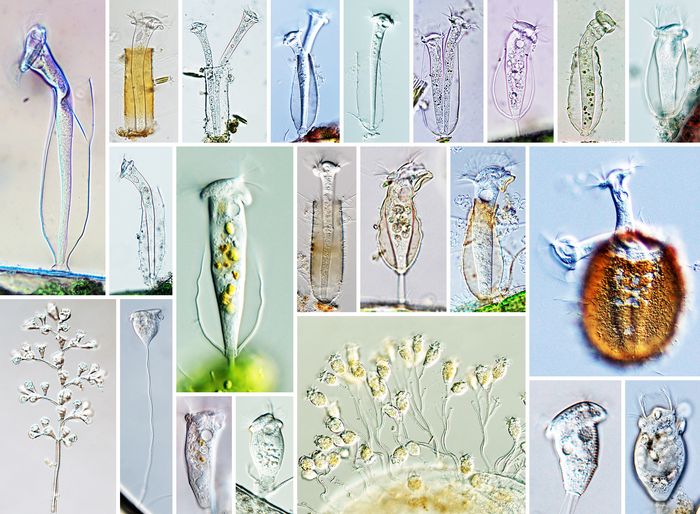This study is led by Dr. Ying Yan (Institute of Evolution & Marine Biodiversity, Ocean University of China). Ciliated protists represent one of the most primitive lineages of eukaryotes, with nuclear dimorphism, a distinctive sexual process (conjugation), and extensive genome rearrangements. Sessilida, among diverse ciliate lineages, is the only group containing members living a colonial lifestyle, i.e., many cells are ‘connected’ by their stalk and a colony is formed through binary fission. This may hint to an independent evolutionary attempt for multicellularity, although they are still single-celled organisms. Besides, Sessilida exists in various habitats and demonstrates great diversity (e.g., the specimens shown in Figure 1).

Credit: ©Science China Press
This study is led by Dr. Ying Yan (Institute of Evolution & Marine Biodiversity, Ocean University of China). Ciliated protists represent one of the most primitive lineages of eukaryotes, with nuclear dimorphism, a distinctive sexual process (conjugation), and extensive genome rearrangements. Sessilida, among diverse ciliate lineages, is the only group containing members living a colonial lifestyle, i.e., many cells are ‘connected’ by their stalk and a colony is formed through binary fission. This may hint to an independent evolutionary attempt for multicellularity, although they are still single-celled organisms. Besides, Sessilida exists in various habitats and demonstrates great diversity (e.g., the specimens shown in Figure 1).
However, until now, very little is known about the evolution and phylogeny of sessilids. Moreover, it is always difficult to unite molecular phylogeny and the traditional morphology-based classification. The inconsistencies between the traditional morphology-based classification and molecular phylogeny have brought great difficulties in exploring the phylogenetic position of each species and the phylogenetic relationship among species in this group.
In this study, the authors reconstructed the phylogenetic trees of Sessilida based on dozens of new data of marker genes and suggested establishing two new families (Figure 2A, B). Unlike most previous studies associated predominantly with in vivo morphological characters, the authors turned their attention to the infraciliature and silverline system revealed after silver staining. They found that the infraciliature, especially the infundibular polykinety 3 (P3) structure, is likely to be a phylogenetically informative character that can reconcile many inconsistencies between classical classification and molecular systematics (Figure 2C).
The authors showed that some morphologically disparate but phylogenetically related species share a similar P3 structure, and some morphologically indistinguishable but phylogenetically divergent taxa have different P3 structures. This breaks the stereotype that P3 is only suitable for species discrimination, and it could be a suprageneric diagnostic feature. Similarly, the value of differences between densely spaced and sparsely spaced silverline in the taxonomy of Sessilida is also likely underrated.
In addition, the phylogeny of an under-researched family Vaginicolidae was systematically analyzed. Species of this family have a protective lorica, some of which are equipped with interestingly closable structures (video 1, 2). The results challenged the reliability of several characters used for genera separation. The findings of this study provide important insights into the origin and evolution of Sessilida.
See the article:
Lu, B., Hu, X., Warren, A., Song, W., and Yan, Y. (2023). From oral structure to molecular evidence: new insights into the evolutionary phylogeny of the ciliate order Sessilida (Protista, Ciliophora), with the establishment of two new families and new contributions to the poorly studied family Vaginicolidae. Sci China Life Sci 66, https://doi.org/10.1007/s11427-022-2268-2
Journal
Science China Life Sciences
DOI
10.1007/s11427-022-2268-2




